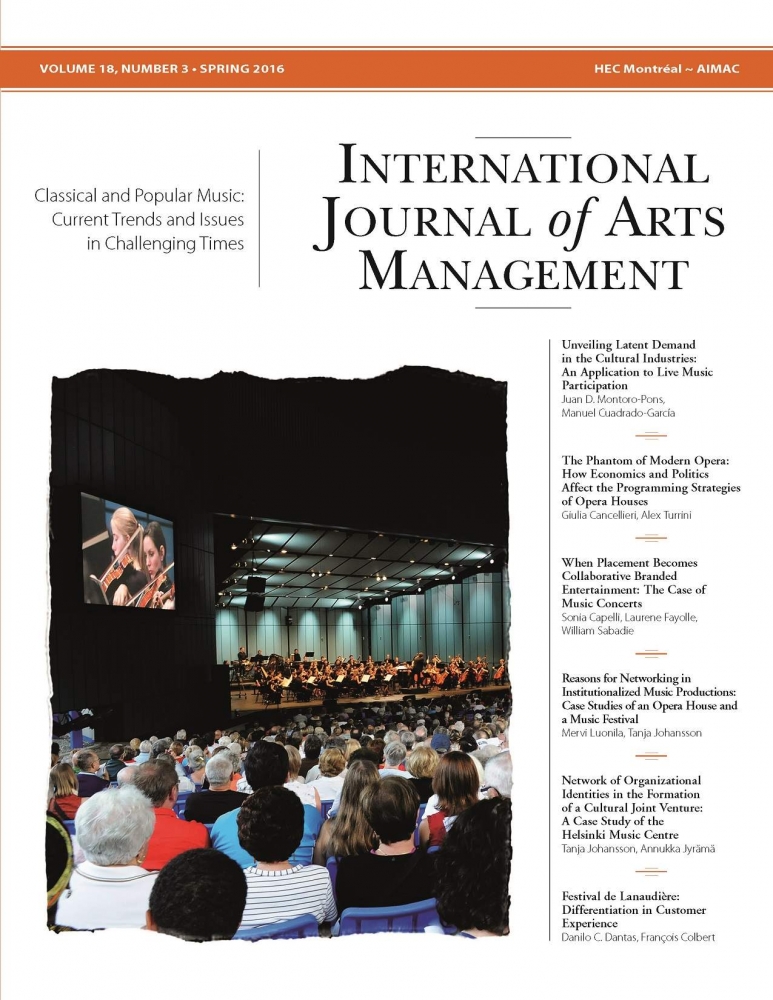IJAM Volume 18 Number 3 (PDF)
Product: Journal
$53.00 CA
EDITOR’S NOTE
Classical and Popular Music: Current Trends and Issues in Challenging Times
André Courchesne
The theme of this issue of IJAM is music, from both the classical and popular traditions, at a moment when the business models for music are being challenged and renewed, in terms of creation, programming and distribution. In order to better understand how arts managers and their organizations adapt to the new context, we present six articles reflecting the latest developments in marketing and management within the arts.
In response to the declining revenues for recorded music, a large number of artists and managers are investigating how to increase attendance at live concerts. Our first article, by Juan D. Montoro-Pons and Manuel Cuadrado-García, analyzes a specific segment of potential attenders of popular music in Spain. Using secondary data from a cultural habits survey, the authors establish a profile of these potential attenders and suggest how to increase overall attendance, among both actual and potential attenders.
Despite the surge in the number of new music compositions, opera houses are often reluctant to stage modern and contemporary works, especially under uncertain economic and political conditions. Our second contribution, by Giulia Cancellieri and Alex Turrini, analyzes the productions of 30 opera houses in Italy over five years in order to determine the factors involved in their programming choices. The results suggest that pressure from the audience is a major obstacle to artistic renewal in programming. As public funding seems to have little influence on programming choices, openness to risk on the part of private local sponsors may positively moderate the negative effect of market pressures on modern and contemporary programming strategies.
Since a growing number of artistic organizations rely on private support, researchers have explored what type of sponsorship and branding may be the most effective. In “When Placement Becomes Collaborative Branded Entertainment: The Case of Music Concerts,” Sonia Capelli, Laurene Fayolle and William Sabadie review four kinds of message related to four different strategies: sponsorship, branded entertainment, collaborative placement and collaborative branded entertainment. The research suggests that, in relation to attitude towards the brand, collaborative branded entertainment is the most effective.
Our next two articles concern networks among musical institutions in Finland; both explore the concept of network, one based on external influences, the other in relation to organizational identities. The first, by Mervi Luonila and Tanja Johansson, investigates the reasons for networking, based on two case studies: the Finnish National Opera and the Pori Jazz Festival. This work focuses on the different stakeholders’ perceptions of the value of networking and the motives for establishing and maintaining network ties. The results suggest that the different sources of financing influence the quality and quantity of organizational network ties. As well, strong network ties function as a platform for reciprocal collaboration, which creates value for both internal and external stakeholders.
The second study of networks, contributed by Tanja Johansson and Annukka Jyrämä, focuses on the case of the Helsinki Music Centre, opened in 2011. The construction of a world-class music centre in the heart of Helsinki was a joint venture of the Sibelius Academy, the Radio Symphony Orchestra, the Helsinki Philharmonic Orchestra and a for-profit service organization. The authors conclude that while the main actors share similar visions and fears, they also have distinct identities. Johansson and Jyrämä argue that acknowledgement of the influence of networked organizational identities on tensions and expectations, when a new joint venture is being formed, is vital for the future cooperation of cultural actors.
Finally, Danilo C. Dantas and François Colbert present a Company Profile of the Festival de Lanaudière, the largest classical music festival in Canada. Large music organizations are facing increasing competition today due to the growing availability of major concerts and operas shown in cinemas, through cable television stations and on the Internet. In addition, music audiences’ increasingly eclectic tastes and a multiplication of summer events forced the Festival de Lanaudière to review its positioning in order to differentiate itself by offering a unique customer experience. The article illustrates how the Festival identified and implemented its main differentiating factors: its impressive amphitheatre, its large screens and its tourist packages.
André Courchesne
Editor
